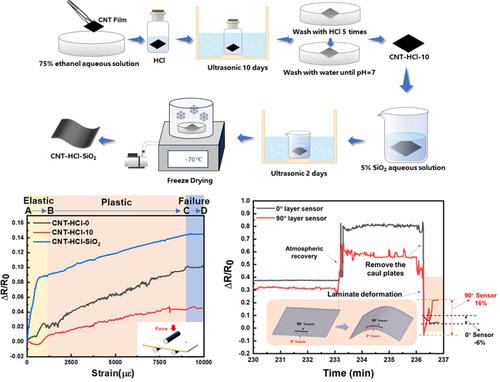Nano-particles doped carbon nanotube films for in-situ monitoring of temperature and strain during the processing of carbon fiber/epoxy composites
IF 4.7
2区 材料科学
Q2 MATERIALS SCIENCE, COMPOSITES
引用次数: 0
Abstract
Carbon nanotube (CNT) film is favored in structural health monitoring of advanced composite materials, primarily due to its commendable mechanical properties and piezoresistive properties. Nonetheless, floating catalytic chemical vapor deposition (FCCVD) is an attractive method for fabrication of CNT films, and the electrical response to strain of FCCVD-prepared CNT films is impeded by high aspect ratio and lamellar packing structure. For this purpose, FCCVD CNT films were modified by HCl dissolving Fe impurities, nano-SiO2 particles doping and freeze-drying in combination to increase the spacing between CNTs and its networks as well as their strain sensitivities. It showed that the gauge factor (GF) according to the variation of resistance (ΔR/R0) of the co-modified film (CNT-HCl-SiO2 film) was up to 15.6 for the tensile strain at the bottom surface of unidirectional carbon fiber reinforced plastic (CFRP) laminates during the process of bending tests. The bending cycle experiment of the CFRP showed relatively stable changes of ΔR/R0 with the strains for CNT-HCl-SiO2 film, while that of the pristine CNT film (CNT-HCl-0 film) displayed unstable non-monotonic changes and that of HCl purified CNT film (CNT-HCl-10 film) revealed a gradual declining tendency. Moreover, the ΔR/R0 of CNT-HCl-SiO2 film exhibited excellent sensitivity to the strains of multiple bistable-deformations of cross-ply CFRP laminates. Strain gauge analysis indicated that a 51% increase of ΔR/R0 of CNT-HCl-SiO2 film at the 90° layer surface corresponded to the average strain of 434 με, meanwhile a 37% increase of ΔR/R0 of the CNT film at the 0° layer surface corresponded to the strain of averagely −173.9 με, and both exhibited super high GFs of 1175 and 2108, respectively. Based on this high sensitivity, CNT-HCl-SiO2 film also had the ability to predict the release of residual stress during the demoulding process of CFRP.

用于现场监测碳纤维/环氧树脂复合材料加工过程中的温度和应变的纳米颗粒掺杂碳纳米管薄膜
碳纳米管(CNT)薄膜在先进复合材料的结构健康监测中备受青睐,这主要归功于其值得称道的机械性能和压阻特性。然而,浮动催化化学气相沉积(FCCVD)是一种极具吸引力的 CNT 薄膜制备方法,而高纵横比和片状堆积结构阻碍了 FCCVD 制备的 CNT 薄膜对应变的电响应。为此,采用盐酸溶解铁杂质、掺杂纳米二氧化硅颗粒和冷冻干燥相结合的方法对 FCCVD CNT 薄膜进行改性,以增加 CNT 及其网络之间的间距,提高其应变敏感性。结果表明,在弯曲试验过程中,根据共修饰薄膜(CNT-HCl-SiO2 薄膜)电阻(ΔR/R0)的变化,单向碳纤维增强塑料(CFRP)层压板底面拉伸应变的量规因子(GF)高达 15.6。在 CFRP 的弯曲循环实验中,CNT-HCl-SiO2 膜的ΔR/R0 随应变的变化相对稳定,而原始 CNT 膜(CNT-HCl-0 膜)的ΔR/R0 则表现出不稳定的非单调变化,HCl 纯化 CNT 膜(CNT-HCl-10 膜)的ΔR/R0 则呈逐渐下降趋势。此外,CNT-HCl-SiO2 薄膜的 ΔR/R0 对交叉层 CFRP 层板的多重双稳态变形应变表现出极佳的灵敏度。应变计分析表明,在 90° 层表面,CNT-HCl-SiO2 薄膜的 ΔR/R0 增加 51%,对应的平均应变为 434 με,而在 0° 层表面,CNT 薄膜的 ΔR/R0 增加 37%,对应的平均应变为-173.9 με,两者分别表现出 1175 和 2108 的超高 GFs。基于这种高灵敏度,CNT-HCl-SiO2 薄膜还具有预测 CFRP 脱模过程中残余应力释放的能力。
本文章由计算机程序翻译,如有差异,请以英文原文为准。
求助全文
约1分钟内获得全文
求助全文
来源期刊

Polymer Composites
工程技术-材料科学:复合
CiteScore
7.50
自引率
32.70%
发文量
673
审稿时长
3.1 months
期刊介绍:
Polymer Composites is the engineering and scientific journal serving the fields of reinforced plastics and polymer composites including research, production, processing, and applications. PC brings you the details of developments in this rapidly expanding area of technology long before they are commercial realities.
 求助内容:
求助内容: 应助结果提醒方式:
应助结果提醒方式:


